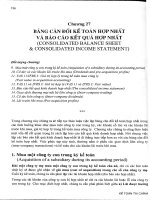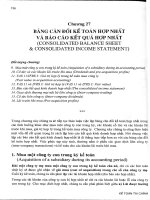Gíao trình kế toán bằng tiếng anh ch07
Bạn đang xem bản rút gọn của tài liệu. Xem và tải ngay bản đầy đủ của tài liệu tại đây (1.68 MB, 47 trang )
Chapter 7
Incremental Analysis
Learning Objectives
After studying this chapter, you should be able to:
[1] Identify the steps in management’s decision-making process.
[2] Describe the concept of incremental analysis.
[3] Identify the relevant costs in accepting an order at a special price.
[4] Identify the relevant costs in a make-or-buy decision.
[5] Identify the relevant costs in determining whether to sell or process materials
further.
[6] Identify the relevant costs to be considered in repairing, retaining, or replacing
equipment.
[7] Identify the relevant costs in deciding whether to eliminate an unprofitable
segment or product.
7-1
Preview of Chapter 7
Managerial Accounting
Sixth Edition
Weygandt Kimmel Kieso
7-2
Management’s Decision-Making Process
Making decisions is an important management function.
Does not always follow a set pattern.
Decisions vary in scope, urgency, and importance.
Steps usually involved in process include:
Illustration 7-1
7-3
LO 1 Identify the steps in management’s decision-making process.
Management’s Decision-Making Process
In making business decisions,
Considers both financial and non-financial information.
Financial information
7-4
►
Revenues and costs, and
►
Effect on overall profitability.
Non-financial information
►
Effect on employee turnover
►
The environment
►
Overall company image.
LO 1 Identify the steps in management’s decision-making process.
Management’s Decision-Making Process
Incremental Analysis Approach
7-5
Decisions involve a choice among alternative actions.
Process used to identify the financial data that change
under alternative courses of action.
►
Both costs and revenues may vary or
►
Only revenues may vary or
►
Only costs may vary
LO 2 Describe the concept of incremental analysis.
Management’s Decision-Making Process
How Incremental Analysis Works
7-6
Illustration 7-2
Incremental revenue is $15,000 less under Alternative B.
Incremental cost savings of $20,000 is realized.
Alternative B produces $5,000 more net income.
LO 2 Describe the concept of incremental analysis.
Management’s Decision-Making Process
How Incremental Analysis Works
Important concepts used in incremental analysis:
7-7
Relevant cost.
Opportunity cost.
Sunk cost.
LO 2 Describe the concept of incremental analysis.
Management’s Decision-Making Process
How Incremental Analysis Works
7-8
Sometimes involves changes that seem contrary to
intuition.
Variable costs sometimes do not change under
alternatives.
Fixed costs sometimes change between alternatives.
Incremental analysis not the same as CVP analysis.
LO 2 Describe the concept of incremental analysis.
Management’s Decision-Making Process
Review Question
Incremental analysis is the process of identifying the financial
data that
a. Do not change under alternative courses of
action.
b. Change under alternative courses of action.
c. Are mixed under alternative courses of action.
d. None of the above.
7-9
LO 2 Describe the concept of incremental analysis.
7-10
Types of Incremental Analysis
7-11
1.
Accept an order at a special price.
2.
Make or buy component parts or finished products.
3.
Sell or process further them further
4.
Repair, retain, or replace equipment.
5.
Eliminate an unprofitable business segment or
product.
Types of Incremental Analysis
Accept an Order at a Special Price
7-12
Obtain additional business by making a major price
concession to a specific customer.
Assumes that sales of products in other markets are
not affected by special order.
Assumes that company is not operating at full capacity.
LO 3 Identify the relevant costs in accepting an order at a special price.
Types of Incremental Analysis
Accept an Order at a Special Price
Illustration: Sunbelt Company produces 100,000 Smoothie
blenders per month, which is 80% of plant capacity. Variable
manufacturing costs are $8 per unit. Fixed manufacturing costs are
$400,000, or $4 per unit. The blenders are normally sold directly to
retailers at $20 each. Sunbelt has an offer from Kensington Co. (a
foreign wholesaler) to purchase an additional 2,000 blenders at $11
per unit. Acceptance of the offer would not affect normal sales of
the product, and the additional units can be manufactured without
increasing plant capacity. What should management do?
7-13
LO 3 Identify the relevant costs in accepting an order at a special price.
Types of Incremental Analysis
Accept an Order at a Special Price
Illustration 7-4
7-14
Fixed costs do not change since within existing capacity – thus
fixed costs are not relevant.
Variable manufacturing costs and expected revenues change –
thus both are relevant to the decision.
LO 3 Identify the relevant costs in accepting an order at a special price.
Cobb Company incurs costs of $28 per unit ($18 variable and $10
fixed) to make a product that normally sells for $42. A foreign
wholesaler offers to buy 5,000 units at $25 each. Cobb will incur
additional shipping costs of $1 per unit. Compute the increase or
decrease in net income Cobb will realize by accepting the special
order, assuming Cobb has excess operating capacity. Should
Cobb Company accept the special order?
Accept
or
Reject?
7-15
LO 3
Types of Incremental Analysis
Make or Buy
Illustration: Baron Company incurs the following annual costs in
producing 25,000 ignition switches for motor scooters.
Illustration 7-5
Instead of making its own switches, Baron Company might
purchase the ignition switches at a price of $8 per unit. “What
should management do?”
7-16
LO 4 Identify the relevant costs in a make-or-buy decision.
Types of Incremental Analysis
Make or Buy
Illustration 7-6
7-17
Total manufacturing cost is $1 higher per unit than purchase price.
Must absorb at least $50,000 of fixed costs under either option.
LO 4 Identify the relevant costs in a make-or-buy decision.
Types of Incremental Analysis
Make or Buy – Opportunity Cost
The potential benefit that may be obtained from following
an alternative course of action.
7-18
LO 4 Identify the relevant costs in a make-or-buy decision.
Types of Incremental Analysis
Make or Buy – Opportunity Cost
Illustration: Assume that through buying the switches, Baron
Company can use the released productive capacity to generate
additional income of $38,000 from producing a different product.
This lost income is an additional cost of continuing to make the
switches in the make-or-buy decision.
Illustration 7-7
7-19
LO 4 Identify the relevant costs in a make-or-buy decision.
Types of Incremental Analysis
Review Question
In a make-or-buy decision, relevant costs are:
a. Manufacturing costs that will be saved.
b. The purchase price of the units.
c. Opportunity costs.
d. All of the above.
7-20
LO 4 Identify the relevant costs in a make-or-buy decision.
Juanita Company must decide whether to make or buy some of its
components for the appliances it produces. The costs of producing
166,000 electrical cords for its appliances are as follows.
Direct materials
Direct labor
$90,000
20,000
Variable overhead
Fixed overhead
$32,000
24,000
Instead of making the electrical cords at an average cost per unit of
$1.00 ($166,000 ÷ 166,000), the company has an opportunity to buy
the cords at $0.90 per unit. If the company purchases the cords, all
variable costs and one-fourth of the fixed costs will be eliminated.
(a) Prepare an incremental analysis showing whether the company
should make or buy the electrical cords. (b) Will your answer be
different if the released productive capacity will generate additional
income of $5,000?
7-21
LO 4
(a) Prepare an incremental analysis showing whether the company
should make or buy the electrical cords.
Juanita Company will incur $1,400 of additional costs if it buys the
electrical cords rather than making them.
7-22
LO 4
(b) Will your answer be different if the released productive capacity
will generate additional income of $5,000?
Yes, net income will be increased by $3,600 if Juanita Company
purchases the electrical cords rather than making them.
7-23
LO 4
7-24
Types of Incremental Analysis
Sell or Process Further
May have option to sell product at a given point in
production or to process further and sell at a higher
price.
Decision Rule:
Process further as long as the incremental revenue from
such processing exceeds the incremental processing
costs.
7-25
LO 5 Identify the relevant costs in determining whether
to sell or process materials further.









